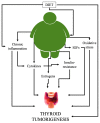Obesity and Thyroid Cancer Risk: An Update
- PMID: 35162142
- PMCID: PMC8834607
- DOI: 10.3390/ijerph19031116
Obesity and Thyroid Cancer Risk: An Update
Abstract
Thyroid cancer (TC) is the most common endocrine malignancy worldwide and its incidence has increased dramatically in recent years. In parallel, the prevalence of overweight and obesity has also increased, suggesting a possible link between these two diseases. Indeed, low-grade chronic inflammation, altered cytokine levels, insulin resistance, oxidative stress, and hormonal changes that occur in obese patients are all factors that contribute to the occurrence and growth of TC. In this review, the most recent evidence supporting the potential role of the mechanisms linking obesity to TC will be discussed.
Keywords: cytokines; estrogens; insulin; insulin resistance; obesity; overweight; oxidative stress; risk factors; thyroid carcinoma.
Conflict of interest statement
The authors declare no conflict of interest.
Figures

Similar articles
-
Obesity and thyroid cancer: a clinical update.Thyroid. 2014 Feb;24(2):190-9. doi: 10.1089/thy.2013.0232. Epub 2013 Sep 25. Thyroid. 2014. PMID: 23879222 Review.
-
The association of obesity with thyroid carcinoma risk.Cancer Med. 2022 Feb;11(4):1136-1144. doi: 10.1002/cam4.4498. Epub 2022 Jan 15. Cancer Med. 2022. PMID: 35032114 Free PMC article. Review.
-
Obesity and thyroid cancer: epidemiologic associations and underlying mechanisms.Obes Rev. 2013 Dec;14(12):1006-22. doi: 10.1111/obr.12070. Epub 2013 Aug 28. Obes Rev. 2013. PMID: 24034423 Review.
-
Obesity and thyroid cancer.Front Biosci (Schol Ed). 2011 Jan 1;3(2):555-64. doi: 10.2741/s171. Front Biosci (Schol Ed). 2011. PMID: 21196396 Review.
-
Obesity as a risk factor for thyroid cancer.Curr Opin Endocrinol Diabetes Obes. 2020 Oct;27(5):358-363. doi: 10.1097/MED.0000000000000556. Curr Opin Endocrinol Diabetes Obes. 2020. PMID: 32740043 Review.
Cited by
-
Weighty Matters: The Obesity-Thyroid Nodule Connection Unveiling the Impact of Obesity on Thyroid Cancer Risk.Medicina (Kaunas). 2023 Sep 14;59(9):1658. doi: 10.3390/medicina59091658. Medicina (Kaunas). 2023. PMID: 37763777 Free PMC article.
-
Machine learning to predict the occurrence of thyroid nodules: towards a quantitative approach for judicious utilization of thyroid ultrasonography.Front Endocrinol (Lausanne). 2024 May 7;15:1385836. doi: 10.3389/fendo.2024.1385836. eCollection 2024. Front Endocrinol (Lausanne). 2024. PMID: 38774231 Free PMC article.
-
Cancer screening in patients with acromegaly: a plea for a personalized approach and international registries.Rev Endocr Metab Disord. 2025 Aug;26(4):525-538. doi: 10.1007/s11154-025-09957-6. Epub 2025 Mar 15. Rev Endocr Metab Disord. 2025. PMID: 40088375 Free PMC article. Review.
-
PRMT1 accelerates cell proliferation, migration, and tumor growth by upregulating ZEB1/H4R3me2as in thyroid carcinoma.Oncol Rep. 2023 Dec;50(6):210. doi: 10.3892/or.2023.8647. Epub 2023 Oct 20. Oncol Rep. 2023. PMID: 37859611 Free PMC article.
-
Gauging the Awareness of Physicians in Saudi Arabia Regarding Risk Factors for Thyroid Cancer.Cureus. 2024 Feb 6;16(2):e53747. doi: 10.7759/cureus.53747. eCollection 2024 Feb. Cureus. 2024. PMID: 38465048 Free PMC article.
References
-
- Agate L., Lorusso L., Elisei R. New and old knowledge on differentiated thyroid cancer epidemiology and risk factors. J. Endocrinol. Investig. 2012;35:3–9. - PubMed
Publication types
MeSH terms
LinkOut - more resources
Full Text Sources
Other Literature Sources
Medical

